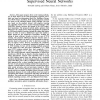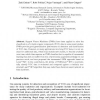93 search results - page 14 / 19 » Learning to Detect Objects of Many Classes Using Binary Clas... |
TNN
2010
13 years 2 months ago
2010
This paper proposes three novel training methods, two of them based on the back-propagation approach and a third one based on information theory for Multilayer Perceptron (MLP) bin...
CVPR
2010
IEEE
14 years 3 months ago
2010
IEEE
Psychologists have proposed that many human-object interaction activities form unique classes of scenes. Recognizing these scenes is important for many social functions. To enable...
GECCO
2006
Springer
13 years 11 months ago
2006
Springer
Many data mining applications involve the task of building a model for predictive classification. The goal of such a model is to classify examples (records or data instances) into...
ISCIS
2005
Springer
14 years 28 days ago
2005
Springer
Support Vector Machines (SVMs) have been applied to solve the classification of volatile organic compounds (VOC) data in some recent studies. SVMs provide good generalization perfo...
ICCV
2011
IEEE
12 years 9 months ago
2011
IEEE
Software available at http://disi.unitn.it/~uijlings or http://koen.me/research/
For object recognition, the current state-of-the-art is based on exhaustive search. However, to ...



